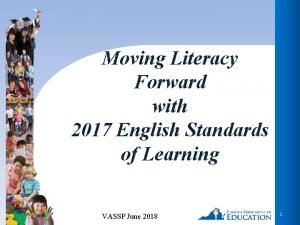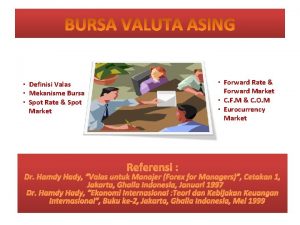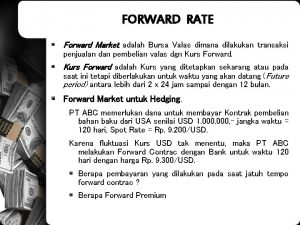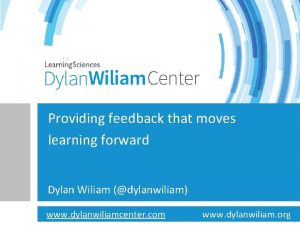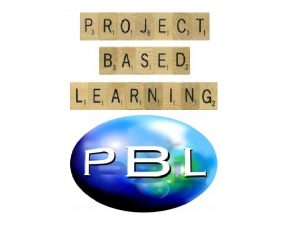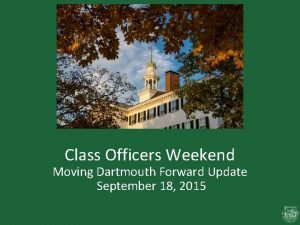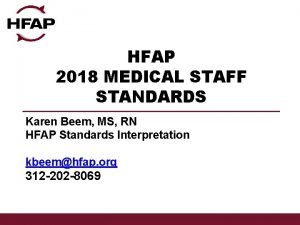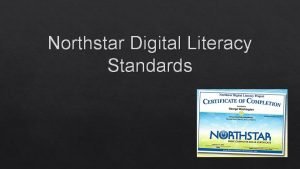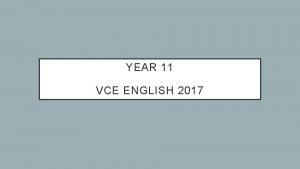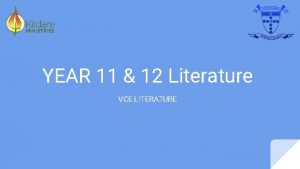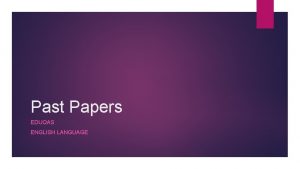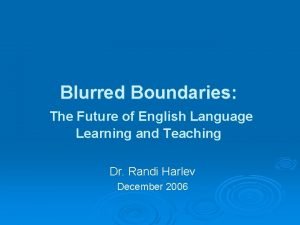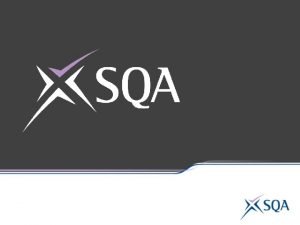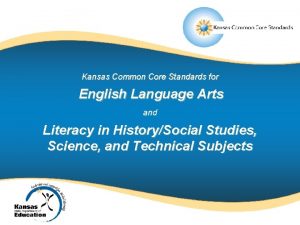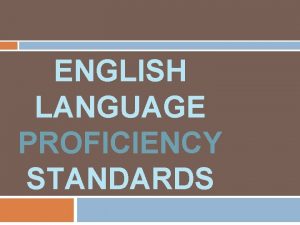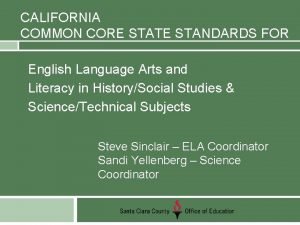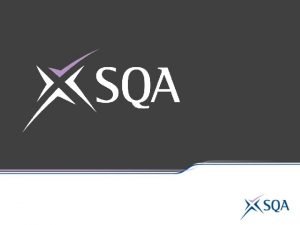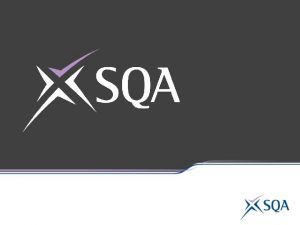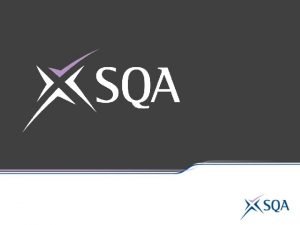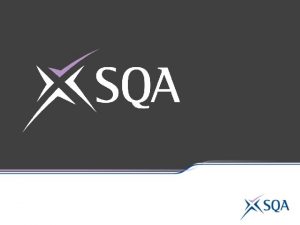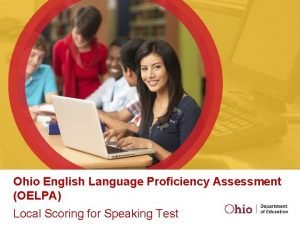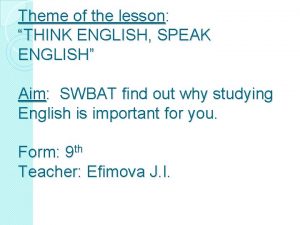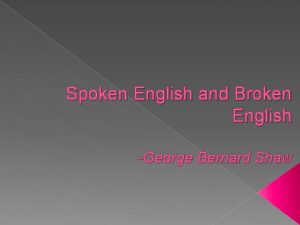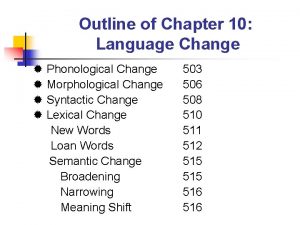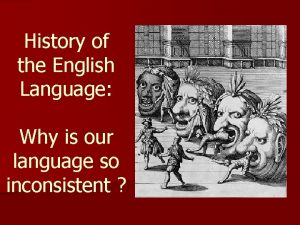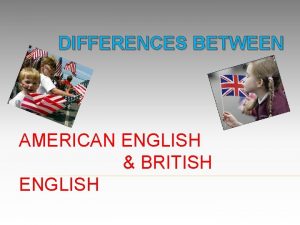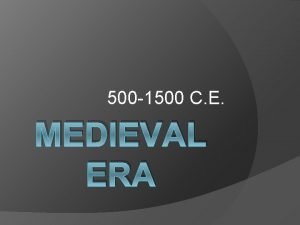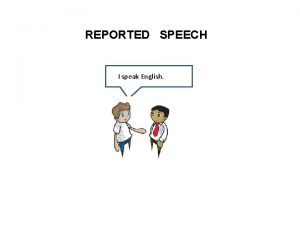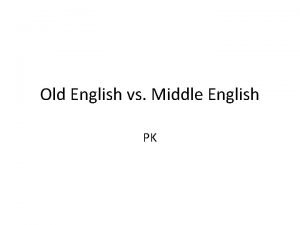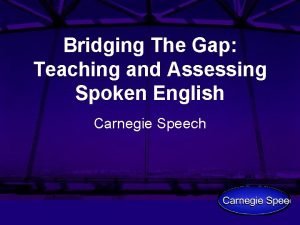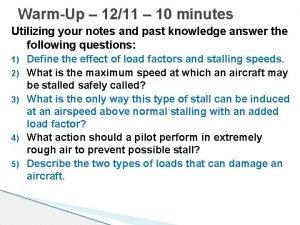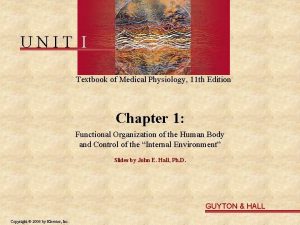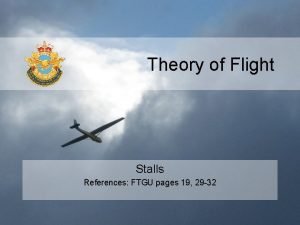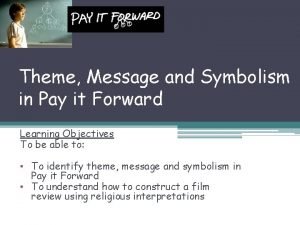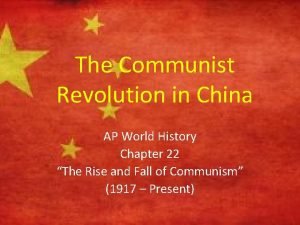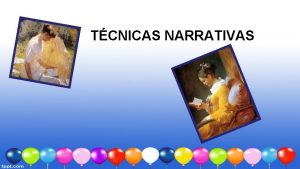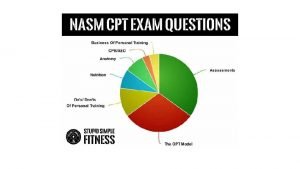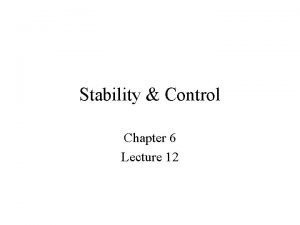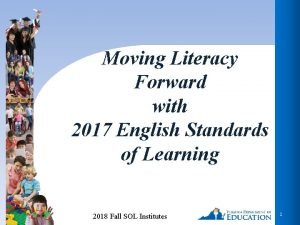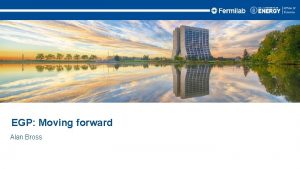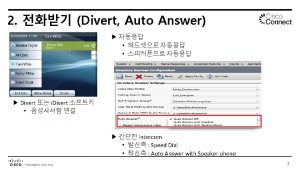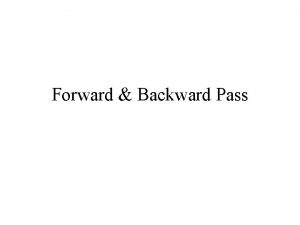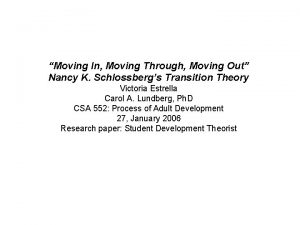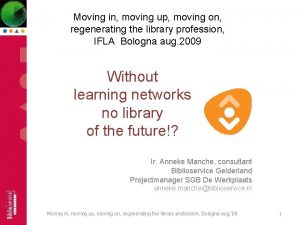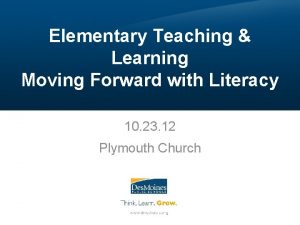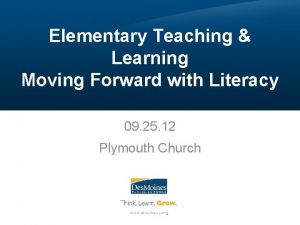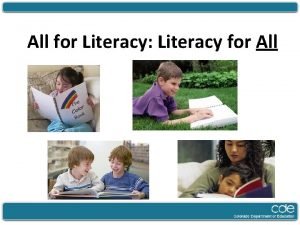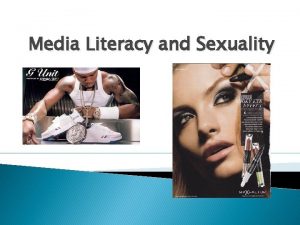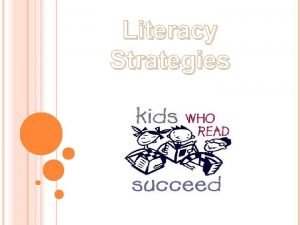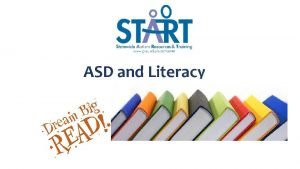Moving Literacy Forward with 2017 English Standards of




















































- Slides: 52

Moving Literacy Forward with 2017 English Standards of Learning VASSP June 2018 1

Profile of a Virginia Graduate (1 of 2) • Describes knowledge, skills, competencies, and experiences students should attain during K 12 education to make them “lifeready. ” • English Standards were the first to be developed under the Profile. 2

Profile of a Virginia Graduate (2 of 2) 3

The 5 C’s 4

Summary of Changes in the 2017 English Standards of Learning • Alignment with the 5 Cs: Critical Thinking, Creative Thinking, Communication, Collaboration, and Citizenship • Alignment to the applicable VA Workplace Readiness Skills • Reorganization of K-3 to align with 4 -12 • Expansion of technical reading & writing in grades 9 -12 5

Summary of Changes in the 2017 English Standards of Learning (1 of 5) • Introduction of reflective writing in grades 612 • Expansion of skills for collaboration, consensus-building, team-building, and working toward common goals • Creation of standards in reading requiring comparing/contrasting details in literary and informational nonfiction texts • Expansion of requirements for nonfiction/informational/technical reading in grades 4 -12 6

Summary of Changes in the 2017 English Standards of Learning (2 of 5) • • Renamed Communication strand now Communication & Multimodal Literacies. Reflects the integration of multiple modes of communication and expression, digital citizenship, and current best practices Includes and encourage options such as podcasts, presentations with visuals and media, blogs, etc.

Summary of Changes in the 2017 English Standards of Learning (3 of 5) Multimodal • Strategic use of two or more codependent modes of communication • Both modes are essential to convey the intended message. • For example: graphics, written language, moving images, music, audio, presentation technologies, movement, etc.

Summary of Changes in the 2017 English Standards of Learning (4 of 5) • Emphasis on ethical use of the Internet when gathering & using information • Introduction of a focus on a mode of writing at each grade level: • • 6 th- narrative & reflective 7 th & 8 th – expository & persuasive 9 th & 10 th – persuasive & analytical 11 th & 12 th – persuasive & argumentative 9

Summary of Changes in the 2017 English Standards of Learning (5 of 5) • The strands of the 2017 English Standards: • Communication & Multimodal Literacies • Reading • Writing • Research The goals are to teach students to read, write, research and communicate. The strands are developed separately, but expected to be seamlessly integrated in the classroom. Through the rigorous application of the English Standards of Learning, students become critical thinkers, effective contributors, and global citizens. 10

2017 English Curriculum Framework Now Posted 11

Reviewing Changes The 2017 English Standards of Learning are expanded by the Essential Knowledge, Skills, and Processes (EKSP) in the Curriculum Framework • This is not meant to be an exhaustive list, nor one that limits what is taught in the classroom • The EKSP is not a one-to-one match of the standards • If the standard is self-explanatory, there will be no additional explanation

2017 Curriculum Framework (1 of 3) • Overview of strand on Strand Introduction page • Teacher Notes appear on Introduction page • Suggested Instructional Strategies and Best Practices are on Teacher Notes page • First column Understanding the Standard has been deleted and that information moved to introduction page • CF Columns: Essential Understandings & Essential Skills, Knowledge, and Processes

2017 Curriculum Framework (2 of 3) 14

2017 Curriculum Framework (3 of 3)

2017 English SOL Implementation Timeline (1 of 2) 16

2017 English SOL Implementation Timeline (2 of 2) 17

How do we effectively integrate strands in the English classroom?

Successful English Instruction Integrate the strands • Vocabulary Development • Specific vocabulary from authentic text • Content vocabulary from math, science, and social studies • Reading • Both fiction & nonfiction text • Text-rich environment with variety of text and media • Student choice whenever possible • Writing as a process for a variety of authentic purposes • Regular writing conferences • Use of Writing Portfolios • Research • Ongoing and embedded in the learning process (when applicable) • Communication/Multimodal Literacies

Successful English Instruction Best Practices • Paired texts • Use of text-dependent questions • Use of inference questions • Use of text-based vocabulary • Writing components in every lesson • Frequent research components

Planning for Integration • Select “text” options • Close read all texts for vocabulary, literary elements, class discussion topics, presentation, research, and writing opportunities • Pair the texts for maximum impact • Select strategies and skills • Incorporate writing throughout (Writing instruction is vital) • Units can span multiple days or weeks 21

Why Do People Follow The Crowd? • • • Following the Crowd: Brain Images Offer Clues to How and Why We Conform Herd Behavior Asch Experiment Excerpt from Portrait of the Artist as a Young Man The Lottery Jabari Unmasked Identity The Road Not Taken Scene from Dead Poet’s Society Hidden Camera Social Experiment Proves Most People Are Sheep 22

Topic: Why Do People Follow the Crowd? One Approach • • • Four Corners with anticipatory statements and quick write Class discussion Herd Behavior Following the Crowd: Brain Images… and Asch Experiment Literary View- Excerpt from Portrait of the Artist as a Young Man and Jabari Unmasked Hidden Camera Social Experiment and The Lottery Identity, The Road Not Taken, and Dead Poet’s Society Clip Research Public Service Announcement Unit writing response Revisit anticipatory statements 23

I have my texts- now what? • • • Jigsaw Partner Reading Guided Reading Silent Conversation Socratic Seminar • • • Close Reading Annotation Summarizing Compare/Contrast Vocabulary 24

Four Corners 1) Conformity is a weakness. It supports bad behavior. 2) Conformity is a powerful social mechanism through which we change our ideas about the world. 3) The majority of people will look to see what others are doing and follow their example. 25

Background Information 26

Nonfiction Approach 27

Literary View 28

Paired “Text” • Hidden Camera Social Experiment Proves Most People Are Sheep 29

Another View Dead Poet’s Society clip 30

Research- Student Choice • What is a resistance movement and what has driven these movements in history? • Who are some famous people who did not follow the crowd? What can we learn from them? • What influences create followers? • What are some positive effects of following the crowd? • What are some negative effects of following the crowd? • How does following the crowd impact leadership? 31

Writing- Student Choice Choose one of the following statements and respond with textual support: • 1) Conformity is a weakness. It supports bad behavior. • 2) Conformity is a powerful social mechanism through which we change our ideas about the world. • 3) The majority of people will look to see what others are doing and follow their example. • 4) Free choice. 32

Communication and Multimodal Literacies • Based on your research and writing, create a public service announcement or TED Talk that takes a position on following the crowd • Revisit anticipatory statements in a debate or Socratic seminar 33

Unit Plan Reflection • Did the materials thematically link genres and texts together for maximum impact? • Did the experiences provide an opportunity for students to think critically? • Were students given the opportunity to demonstrate their understanding of the material and apply the skills? 34

The Forgotten “R” • The elimination of the grade 5 Writing SOL assessment threatens writing/research instruction • Writing, like reading, is a life skill and should be included in all curricular areas. • How much writing does your job require?

Taught vs. Assigned Because Writing Matters by Carl Nagin The National Writing Project

When writing is taught… • Teachers model by • Writing with the students • Revealing the hard work of writing • Thinking aloud through revision of their writing • Editing only after revision is complete

Ø Five-Paragraph Papers © Sandra Boynton

Writing Portfolios Document Student Growth • Involving students in documenting their strengths and weaknesses gives them ownership • Record writing conferences by date and suggestions offered • Record progress made • Students can/should incorporate writing from other classes • Focus only on a few corrections at a time. Marking every error is overwhelming for students and a waste of teacher’s time.

Finding the Writer’s Voice • Voice - the personality behind writing • What contributes to voice? • Word choice/diction • Sentence structure • Tone/attitude • Mood • RAFT strategy http: //bekindrewrite. com/2011/08/13/5 -ways-to-find-your-voicein-5 -voices/

NCTE Resolution *DO NOT TEACH GRAMMAR IN ISOLATION* • Resolved, that the National Council of Teachers of English affirm the position that the use of isolated grammar and usage exercises not supported by theory and research is a deterrent to the improvement of students' speaking and writing and that, in order to improve both of these, class time at all levels must be devoted to opportunities for meaningful listening, speaking, reading, and writing; and that NCTE urge the discontinuance of testing practices that encourage the teaching of grammar rather than English language arts instruction. A statement approved by the NCTE Board of Directors or the NCTE Executive Committee http: //www. ncte. org/positions/statements/grammarexercises

Nancy Atwell “ Writers need regular, frequent chunks of time they can count on, anticipate and plan for. Only when we make time for writing in school, designating it a high-priority activity of the English program, will students develop the mind of writers-and the compulsions. ” (Atwell, 1998, 91) 42

The Reading/Writing Connection • Use mentor texts to read like a writer and write like a reader • • • Imitate an author’s style and structure Appreciate the author’s craft Incorporate daily writing • A warm-up prior to beginning a unit of study • Incorporate writing into formative assessment • After a thought provoking reading, discussion, or class experiment, students write their thoughts • Find authentic writing opportunities • Blogging or Social media connections • Editorials and authentic writing • Online such as www. teenink. com

VDOE Updates 44

2017 SOL Progression Charts Reading

2017 SOL Crosswalk 46

Coming Events (1 of 2) • English Textbook Adoption • • • K-5 Reading, 6 -12 Reading/Lit 6 -12 Writing Started January 26, 2018 Reviewers are working over the summer No RVA consensus meeting 47

Coming Events (2 of 2) • Fall 2018 English SOL Institutes • Focus on Integration of 2017 English Standards • October 1 - Abingdon • October 2 - Wytheville • October 11 - Newport News • October 18 - Richmond • October 29 - Staunton • November 14 - Dulles 48

Website Accessibility • Changing website(s) for ADA accessibility • If 2 versions of a doc are posted, ADA version is listed first followed by ‘original word version’ • No more PDF docs • Original format of previous SOL Institute PPTs and handouts will change and may not be included on updated page • Save files now • English website updated each quarter 49

Teacher. Direct

VDOE Disclaimer • Reference within this presentation to any specific commercial or noncommercial product, process, or service by trade name, trademark, manufacturer or otherwise does not constitute or imply an endorsement, recommendation, or favoring by the Virginia Department of Education.

Contact Information Tracy Robertson English Coordinator Tracy. Robertson@doe. virginia. gov Crystal Midlik Elementary English Specialist Crystal. Midlik@doe. virginia. gov Denise Fehrenbach English Specialist Denise. Fehrenbach@doe. virginia. gov Virginia Department of Education Jill Nogueras English/History and Social Science Specialist Jill. Nogueras@doe. virginia. gov Assessment Office Student_Assessment@doe. virginia. gov 52
 2017 english standards of learning curriculum framework
2017 english standards of learning curriculum framework Forward rate adalah
Forward rate adalah Forward rate dan forward market
Forward rate dan forward market Dylan williams feedback
Dylan williams feedback Meet the robinsons
Meet the robinsons Moving dartmouth forward
Moving dartmouth forward Media literacy and information literacy
Media literacy and information literacy Formative assessment analyze and explain this illustration
Formative assessment analyze and explain this illustration People in media vs people as media similarities
People in media vs people as media similarities Cyber literacy for the digital age
Cyber literacy for the digital age Hfap standards 2017
Hfap standards 2017 Northstar digital literacy standards
Northstar digital literacy standards Vce english bell curve
Vce english bell curve Vce literature text list
Vce literature text list Staar released essays
Staar released essays Eduqas english literature past papers
Eduqas english literature past papers Factors determining service standards
Factors determining service standards English literacy in europe
English literacy in europe Sqa higher english understanding standards
Sqa higher english understanding standards Ksde social studies standards
Ksde social studies standards English language proficiency standards scavenger hunt
English language proficiency standards scavenger hunt English content standards
English content standards California content standards english
California content standards english Understanding standards advanced higher geography
Understanding standards advanced higher geography Advanced higher art contextual analysis example
Advanced higher art contextual analysis example Understanding standards advanced higher english
Understanding standards advanced higher english Oelpa standards
Oelpa standards Advanced higher mathematics of mechanics
Advanced higher mathematics of mechanics Oelpa
Oelpa Speak theme
Speak theme Spoken english and broken english g.b. shaw summary
Spoken english and broken english g.b. shaw summary Language change
Language change Father of english tragedy in english literature
Father of english tragedy in english literature Old english vs modern english
Old english vs modern english Differences between americans and british
Differences between americans and british Words american vs british
Words american vs british Old english vs modern english
Old english vs modern english “i speak english” he said that he ……english
“i speak english” he said that he ……english Old english vs middle english examples
Old english vs middle english examples Spoken english and broken english summary
Spoken english and broken english summary Difference between american and british english
Difference between american and british english Bond equivalent yield
Bond equivalent yield When life kicks you let it kick you forward
When life kicks you let it kick you forward Can you recover from a flat spin
Can you recover from a flat spin Backward algorithm example
Backward algorithm example Feed-forward control physiology
Feed-forward control physiology Aft cg vs forward cg
Aft cg vs forward cg Keel surface of aircraft
Keel surface of aircraft Pay it forward themes
Pay it forward themes Collectivization ap world history
Collectivization ap world history Anacronia flashforward
Anacronia flashforward Static postural assessment
Static postural assessment Aft cg vs forward cg
Aft cg vs forward cg
